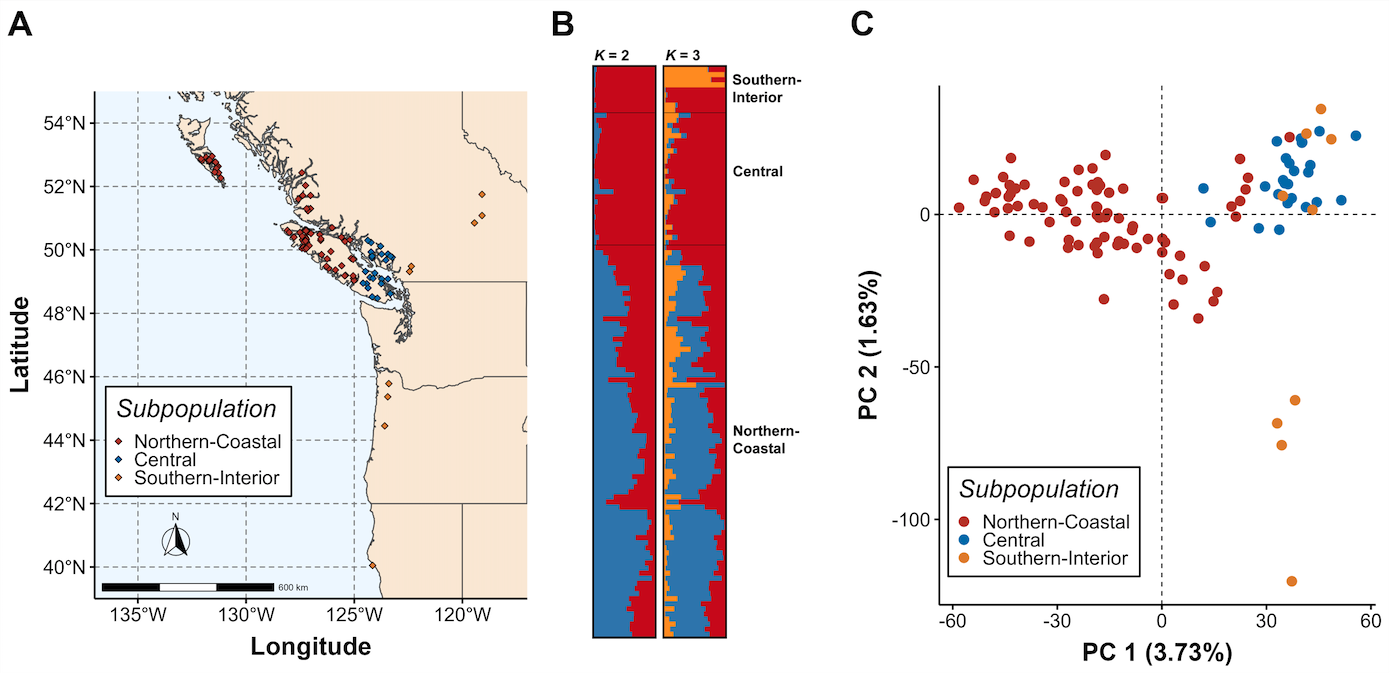Newsroom
Bohlmann Lab research on Western Redcedar genome sheds light on keystone species
Researchers from the Bohlmann lab revealed genomic insights for a cornerstone forest tree species of the Pacific Northwest, the iconic Western Redcedar (WRC). For thousands of years, and long before the arrival of European settlers, WRC has been integral to a multitude of practical, cultural and ceremonial practices of the Indigenous people of the region. WRC serves a central role in the temperate rain forest ecosystem of the Pacific Northwest and into the interior. With its beautiful, rot resistant wood it is a prized building material. Unfortunately, climate change and logging of old-growth WRC pose challenges for the species. The Bohlmann lab published two papers in the journals Genome Research and Evolutionary Applications that share novel findings about the genome, adaptation and resilience of this species.
The team assembled the genome sequence for WRC and analysis found unusual low genetic diversity across the range of the species. While most conifers are highly heterozygous (having two different alleles of each gene, one inherited from each parent), this is not so for WRC, likely due to its ability to self-fertilize (a.k.a. ‘selfing’) without obvious negative effects in the offspring.
“Humans typically don’t mate with close relatives because the risk of genetically inherited illnesses. The same is true for most conifers. Genetic issues crop up when there is a very limited mating pool. Apparently, the Western Redcedar tree doesn’t suffer such inbreeding depression, despite its common self-fertilization”, explains postdoctoral fellow and lead author Dr. Tal Shalev.
Historically conifer genomes have been difficult to study due to their heterozygous nature and sheer size. Conifer genomes are up to 10 times the size of the human genome, having up to 30 billion base pairs (nucleotides that form the structure of DNA) in contrast to our 3 billion base pairs. To sequence the WRC genome, researchers sampled trees produced from several generations of repeated selfing.
“When a tree is derived from several generations of selfing, we expect that it will be more than 98% homozygous across its genome,” says Shalev.
The findings of this study revealed that, despite its overall low genetic diversity, WRC continues to adapt to different environments. These discoveries help us understand how these trees evolve and how WRC populations successfully spread and adapt.
“This may be explained by WRC’s evolutionary history during and following the last ice age, when the species likely spread from a single glacial refugium in northern California. The ability to self-fertilize may have allowed these trees to spread quite quickly northward. There are probably some strong selection pressures to maintain heterozygosity in some parts of the WRC genome,” Shalev explains.

Despite its large, continuous native range across the Pacific Northwest, genetic diversity is unusually low in Western redcedar
With the ubiquity of WRC in the Pacific Northwest, it’s difficult to imagine the abundance of these trees linking back to a small geographic and genetically limited origin. While the discoveries from the publication in Genome Research help to understand the evolution of the WRC species, more recent work from the Bohlmann Lab is shedding light on other important aspects of this magnificent tree.
In a study that made the cover of Evolutionary Applications earlier this year, Dr. Shalev and his co-authors examined thousands of genetic loci (sections of the genome) that are associated with important resistance traits, protecting trees against pathogens and herbivores, as well as growth traits. Some trees within the species are genetically more resilient and have better wood properties. Identifying these trees by their genomic differences will help tree breeders preserve this landmark species in changing climates and better utilize trees for reforestation.
“Instead of using old-growth cedars, we are shifting to planting and harvesting second-growth trees. We need to select for trees that will be resistant to disease and adapted to future climates, helping to maintain ecosystems while producing high quality wood,” Shalev says.
Safeguarding such a pivotal species is important culturally, ecologically and economically.
“Our work is already contributing to speeding up the genotyping and selection process of WRC and putting trees with improved traits into operational seed orchards,”say Shalev.
This body of research and its application for identification of trees that are likely to be healthiest and most productive will save significant costs and time in tree breeding. The Bohlmann Lab continues this work, improving the initial WRC genome assembly and delving further into the genomic traits that will bolster the trees against the ongoing threats of climate change.
Quick links:
- Read the WRC genome sequencing publication: The western redcedar genome reveals low genetic diversity in a self-compatible conifer
- Learn more about the second publication in Evolutionary Applications: Genetic architecture of terpene chemistry and growth traits and the impact of inbreeding on these traits in western redcedar (Thuja plicata)
- Find out more about the Bohlmann lab
